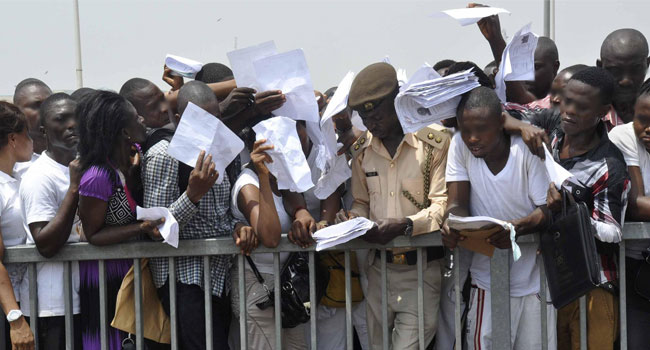
The nation’s unemployment rate has decreased to 4.3% in the second quarter of 2024, compared to 5.3% rate recorded in the first quarter of 2024.
This was contained in the Q2, 2024 Nigerian Labour Force Survey (NLFS) Report released by the National Bureau of Statistics (NBS) on Monday.
The decline in the unemployment rate was recorded after rising three consecutive times between the second quarter of 2023 and first quarter of 2024.
NBS said underemployment rate also declined to 9.2% in Q2, 2024, compared to the rate recorded in Q1, 2024, which was 10.6%.
The Bureau said the unemployment rate among persons with upper-secondary education was 8.5% in Q2 2024, while the unemployment rate among youths aged (15-24 and 25-34 years) in Q2 2024 was 6.5% each and the highest.
It said Urban unemployment was 5.2% in Q2 2024, compared with 6 per cent in Q1 2024, while unemployment in the rural areas was 2.8per cent, down from the 4.3% recorded in Q1 2024.
NBS said the share of those in wage employment was 14.4% in Q2 2024, a marginal decrease from the 16% recorded in Q1 2024.
It said the rate of informal employment, which is the share of employed persons working in the informal sector and informal employment (including agriculture) in Q2 2024 was 93.0%, a slight increase from the rate reported in Q1 2024, 92.7%.
The Bureau said the rate of informal employment among people living in rural areas was 97.5% while the urban informal employment was estimated at 90%.
The NBS survey also collected information on the proportion of Youths aged (15-24 years) who are not in employment, education, or training (NEET).
It said, the NEET rate for the reference quarter was estimated to be 12.5%, a decrease from 14.4% recorded in Q1 of 2024.
According to the survey report, the labour force participation rate stood at 79.5% in Q2 2024, higher than the participation rate recorded in Q1 2024 (77.3%).
The report said the participation rate of men in the labour force under the reviewed period stood at 79.9% while women participation stood at 79.1%.
The participation rate was higher in the rural areas with 83.2%, while the urban areas recorded 77.2%, indicating that most people were engaged in some form of work either for pay or profit, during the reference period.





